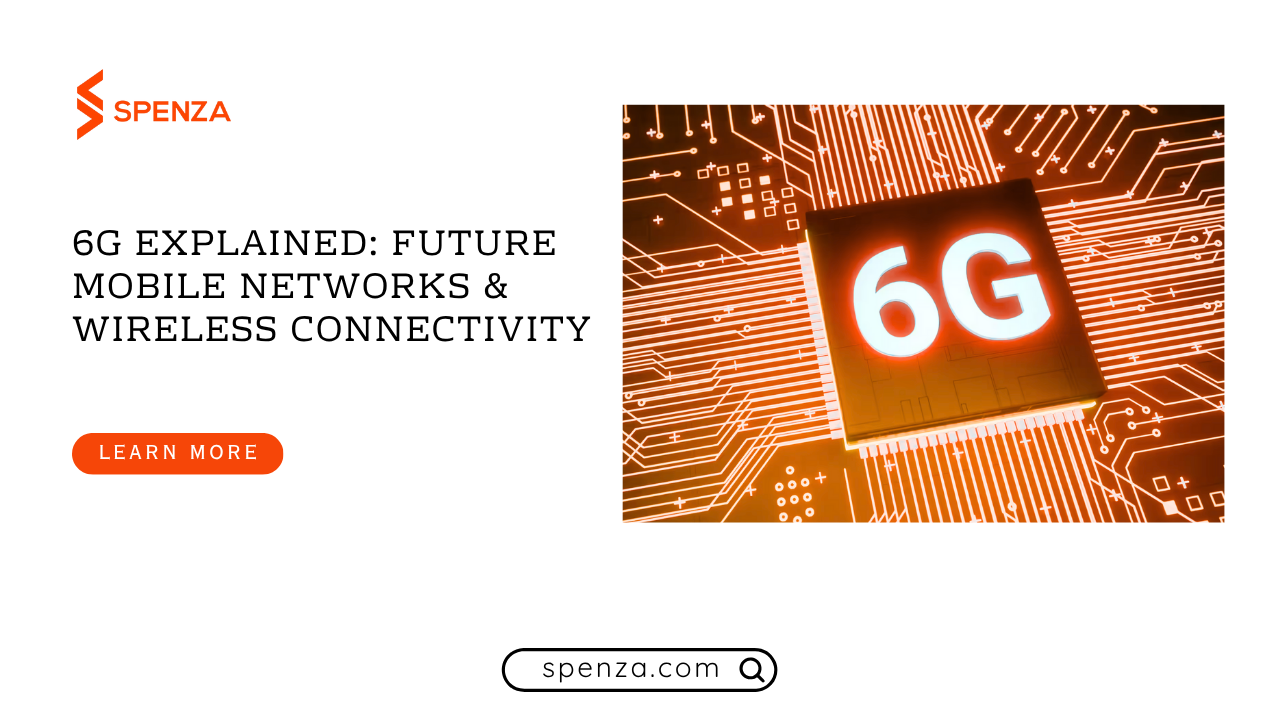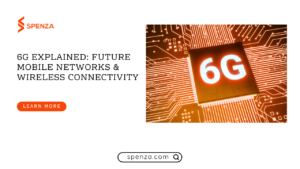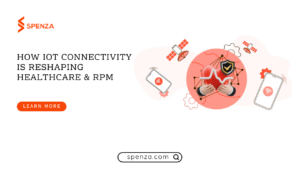TL;DR / At-a-Glance Summary
From High-Speed to Intelligent Connectivity
6G shifts wireless from fast data pipes to intelligent, self-optimizing networks. Devices gain extreme speed, micro-latency, and built-in sensing that lets them interact with environments in real time.
Why 6G Transforms Device Ecosystems
6G breaks today’s limits by enabling holograms, immersive XR, autonomous systems, and instant multi-device coordination across industries.
The Network Layer for Massive IoT Density
6G supports billions of devices with advanced sensing and ultra-dense deployments, powering smart cities, machine fleets, and real-time monitoring at huge scale.
New Satellite Connectivity Standard
6G converges cellular, satellite, and airborne networks, delivering seamless global coverage and intelligent routing anywhere on the planet.
How Spenza Enables 6G-Ready Connectivity
6G becomes practical when devices use flexible, software-driven connectivity. Spenza’s multi-carrier eSIM and orchestration platform prepares today’s IoT fleets for the adaptive, global networks 6G will bring.

6G is the next evolution of mobile and wireless connectivity beyond 5G, expected to roll out in the early 2030s. It envisions ultra-high data rates (hundreds of Gbps or more), ultra-low latency, and pervasive connectivity across both terrestrial and non-terrestrial networks. Key enablers include THz/sub-THz spectrum, network-embedded AI, and integrated sensing capabilities that allow networks to map or monitor the physical world.
6G Is Not Just “Faster 5G”
What makes the world look beyond 5G when most people still adjust to it? The answer sits inside the massive growth of global mobile traffic, which heads toward 430 exabytes per month by 2030. That growth forces the tech world to prepare the next step.
This raises a simple question about 6G Explained. Is it just faster 5G? The short answer stays clear. It is not. The bigger shift with 6G Explained sits in how it blends the physical, digital, and human worlds into one responsive environment.
The goal covers speed, sensing, intelligence, and deeper device coordination. In this blog, the focus stays on what 6G is, why it matters, how it differs from 5G, and the new use cases it supports.
What Is 6G?
6G Explained describes the next generation of wireless connectivity designed for the early 2030s. It aims at extreme data rates, near-zero delay, and an AI-native network core that reacts fast. 6G Explained moves past the limits of 5G and reshapes how devices talk to each other and to the world around them.
The core meaning of what is 6G stays simple. It blends communication with sensing, intelligence, and responsiveness in real time. Devices send data and also read their surroundings. This produces smart networks that predict needs rather than react late. While 5G raised speed and lowered latency, 6G Explained moves fully into intelligence.
It also supports ultra-dense IoT clusters that fill cities, factories, farms, roads, and remote zones. The scale grows massive because 6G aims at device densities between 1 million and 100 million devices per square kilometer. This number sets the first real baseline for extreme sensor networks.
A smooth transition from this idea connects to practical IoT strategies, and many of those fundamentals already sit inside the connected-device principles explained in Spenza’s connected devices guide.
Use cases include immersive communication (AR, VR, holograms), massive IoT at scale, smart cities and industries, and global coverage—even in previously hard-to-reach areas. At the same time, significant challenges remain in standardisation, cost, infrastructure deployment, spectrum regulation, energy efficiency, and security.
When Is 6G Coming?
A clear timeline helps people understand the pace. Many ask what is 6G in daily life, and the answer reveals that it is not a near-term product. It arrives through structured phases that the global telecom community follows carefully.
Industry groups, researchers, and chipmakers already move through early stages. The timeline includes:

This view supports clear expectations and avoids confusion that 6G Explained means something available next year. Many companies also explore early planning because IoT networks take years to prepare. This is also where connectivity management matters, and the idea of future readiness aligns with the simple framework in Spenza’s IoT connectivity management guide.
How Fast Will 6G Be? The Speed, Latency & Performance Jump
Speed becomes the headline feature for many. People ask about 6G vs 5G, and speed explains the biggest gap. But the real shift with 6G Explained comes from the full combination of speed, delay, sensing, and network intelligence operating together.
A few measurable numbers give clear context:
- Peak data rate: 50–200 Gbps
- User-experienced speed: 300–500 Mbps in most areas
- Latency: 0.1–1 ms. Source
These numbers show how wide the performance gap grows in 6G vs 5G. The jump supports real-time holographic communication, instant machine interaction, and new forms of remote control.
This performance also enhances sensing. With Terahertz 6G signals, devices read their surroundings, recognize movement, and sense materials. This new direction changes how wireless works. Many industries that test early systems want these sensing abilities because they help them run secure, efficient operations.
This future speed and sensing story also lines up with the broader need for stronger cost planning, which links naturally to the IoT connectivity cost guide by Spenza.
Key Features That Will Define 6G Networks
6G Explained introduces a set of defining features that reshape how networks behave. The features go beyond raw power and enter combined intelligence.
Each feature links with strong demand from industries waiting for new communication models.

Terahertz Spectrum & Ultra-Fast Connectivity
6G Explained relies on Terahertz 6G bands that support extreme bandwidth. These bands carry huge volumes of data and support very low delay.
Strong Terahertz 6G concepts include:
- Ultra-High-Frequency Waves
- Very Fast Short-Range Data Exchange
- Real-Time Environmental Scanning
- Support for Dense Devices
These points show why the Terahertz 6G area becomes central to new network designs.
AI-Native Wireless Networks
Another shift comes from the AI-native network core. This means AI runs inside the network and makes routing decisions instantly. It reads patterns, predicts traffic, and selects paths.
Core ideas include:
- Predictive Routing
- Real-Time Adjustment
- Improved Signal Stability
- Fast Failure Recovery
These help networks act almost like living systems rather than static infrastructure.
Integrated Satellite + Terrestrial Networking
6G Explained blends ground networks with satellites in a single layer. This helps devices stay connected in remote regions, oceans, air routes, and rural areas.
Key benefits include:
- Wider reach
- Fewer dead zones
- Global coverage for machines
- Smoother roaming
This model supports future IoT systems that cross borders daily.
Holographic & Immersive Communication
Holographic calls require huge bandwidth and edge processing. 6G Explained supports this with its speed and near-zero latency.
Capabilities include:
- 3D presence
- Real-time motion tracking
- Multi-angle rendering
- Natural communication flows
These uses move beyond entertainment and enter areas like education, medicine, and engineering.
Massive IoT & Machine-Type Communication
The scale makes a difference. With density targets between 1 million and 100 million devices per km², extreme IoT becomes real.
This enables:
- Smart factories
- Wide sensor grids
- Traffic systems
- Environmental monitoring
This density aligns with early steps from IoT strategies described in Spenza’s IoT connectivity strategies guide.
Built-In Sensing + Communication Capabilities
Sensing becomes part of the radio signal. Devices read motion, distance, and materials.
Key points include:
- Radar-like behavior
- Location accuracy
- Environment detection
- Security improvements
This sensing layer creates enormous possibilities for automation, robotics, and safety systems.
6G vs 5G: What’s the Real Difference?
People often frame 6G Explained as a more powerful 5G. But the actual difference spans speed, architecture, spectrum, sensing, communication, and intelligence. The clearest way to compare 6G vs 5G comes through a simple table.
| Factor | 6G | 5G |
|---|---|---|
| Speed | 50–200 Gbps | 10 Gbps peak |
| User Speed | 300–500 Mbps | 100–300 Mbps |
| Latency | 0.1–1 ms | 1–10 ms |
| Spectrum | Terahertz | mmWave + Sub-6 |
| Use Cases | sensing, holograms, extreme IoT | mobile broadband |
| AI Level | native | partial |
| Density | up to 100M devices/km² | up to 1M devices/km² |
This comparison shows how wide the gap grows. It also reinforces why businesses must understand what is 6G as early as possible.
How 6G Will Transform Industries
6G Explained leads to major changes because industries need real-time communication, sensing, and high-density device networks. The changes appear in every sector.
Healthcare & Remote Surgery
Ultra-low delay between 0.1 and 1 ms makes real-time robotic surgery possible. Doctors can operate machines from anywhere with fast image transfers, stable feedback loops, and safer remote interventions.
Smart Cities & Infrastructure
Cities will run on dense sensor networks, sometimes reaching 1–100 million devices per square kilometer. This helps manage traffic systems, power grids, air quality monitoring, and public safety operations with far more accuracy.
Autonomous Vehicles & Drones
Vehicles and drones depend on split-second communication. 6G supports this with sensing and near-zero delay, allowing machines to exchange signals instantly, receive updates in real time, prevent accidents, and operate safely in automated flight zones.
Metaverse, XR & Holographic Computing
3D communication becomes practical with 6G. It enables full-body holograms, smooth low-delay rendering, natural blending of physical and digital environments, and real-time XR experiences for work, education, and entertainment.
Manufacturing & Robotics
Robots can work with network intelligence built into 6G. This leads to early fault prediction, real-time coordination between machines, precise remote control, and stable automation across factories and production lines.
Global IoT & Sensor Networks
Extreme device density enables massive IoT deployments. This supports new monitoring systems, better logistics, precision farming, and global tracking networks that operate continuously across borders.
This entire transformation sits in the same category of forward planning seen inside Spenza’s guide on eliminating carrier lock-in for enterprise mobility.
How Spenza Aligns with the Future of 6G Connectivity
Spenza is designed to support both existing and emerging network generations. It already works seamlessly across 2G to 5G, and its architecture leaves room for future 6G integration without requiring major redesigns.
Spenza’s model anticipates a world where devices use multiple communication layers, cellular, satellite, Wi-Fi, and hybrid networks. The platform delivers the flexibility needed for that multi-network reality.
Key capabilities already pointing toward the 6G era include:
- eSIM and global provisioning for fast, scalable deployments
- Dynamic carrier switching to maintain optimal connectivity
- Fleet-wide visibility across devices, networks, and usage
- Advanced orchestration logic for real-time decisions
- Secure subscription and profile control
- Rapid rollout processes for large-scale IoT operations
These features eliminate dependence on any one carrier.
Spenza doesn’t just support today’s connectivity challenges, it lays the groundwork for tomorrow’s 6G-powered world. Its flexible, carrier-agnostic, and future-ready design ensures that enterprises can maintain control, reduce complexity, and scale confidently as networks evolve.
The Future of Wireless: What to Expect Beyond 6G
People who ask “What is 6G?” often ask the next question too: “What comes after it?” The truth is that the future of wireless will continue to move toward stronger sensing, deeper intelligence, tighter integration, and huge numbers of connected devices.
- Wireless technology never stands still. Each generation becomes more powerful, more efficient, and more complex than the one before.
Even today, we can already see early signs of what may follow after 6G. - One major shift is iSIM, which places the device’s network identity directly inside its main chip.
This reduces hardware size, lowers power use, improves security, and makes provisioning much smoother. It fits well with future networks that expect smaller, smarter, and more efficient devices. - Another area is quantum communication, a future technology designed to protect data with extremely secure links that are almost impossible to intercept.
These systems could support finance, government, defense, and other sensitive industries that require maximum security. - We will also see a major rise in space-based internet networks. Satellites will play an even bigger role in the years beyond 6G, building global coverage that works together with ground networks.
This could enable low-latency links from almost anywhere, better emergency communication, planet-wide sensor systems, and even support for missions beyond Earth.
The world after 6G continues the same story: smarter networks, stronger security, and connectivity that reaches farther than ever before.
Conclusion: The Next Chapter in Wireless Connectivity
The world of networks changes quickly, and 6G will bring an even bigger shift. It won’t just make the internet faster, it will make networks smarter. 6G will add new abilities like sensing the environment, using AI to make decisions, using Terahertz waves for huge speed, and supporting many more devices at the same time. This will help improve global IoT systems, remote communication, automation, and new digital experiences.
As mobile demand keeps growing, companies need to prepare early. That means choosing flexible systems that can handle new networks, work across countries, and last through many upgrades.
This is where Spenza fits perfectly. Spenza offers global connectivity, multi-carrier options, and smart network management. These tools help companies build devices that stay ready for future networks, including 6G.The next wireless era is coming fast.
The question is: will your devices be ready?
FAQs
Current research shows no special danger. Every generation follows strict global health standards. Terahertz 6G bands run at low power and require dense infrastructure, which keeps exposure stable and controlled.
Yes. Real-time holograms, responsive XR, and low delay help people communicate in natural ways. Meetings feel smoother, and training becomes more immersive.
Yes. 6G needs new radios, new chips, and new sensing systems. Older 5G or 4G devices cannot use full 6G features. Companies must upgrade hardware over time.
Want your IoT systems to be ready for the future? Reach out to Spenza to get started.






